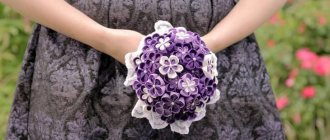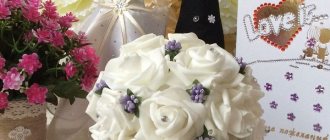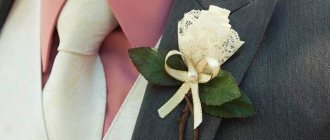During the period of preparation for the wedding, it is not necessary to purchase all the necessary wedding attributes in specialized stores or from private craftsmen; some accessories can be made with your own hands. Such details also include the groom's boutonniere - a flower that matches the bride's composition, which is attached to the pocket or lapel of the jacket. Recently, wedding flowers made from satin ribbons have become fashionable; any girl, even if she has not previously resorted to needlework, can make such an attribute with her own hands, spending a minimum of time.
Photo for inspiration
Manufacturing technique
The most traditional flowers used as a boutonniere are roses, but you can choose others: peonies, dahlias, poppies, daisies and even the most unusual fantasy flowers. All of them are made using the kanzashi technique. This is the Japanese art of folding fabric into flowers, similar to origami. Any ribbons can be used: organza, nylon, rep, but satin ones are more affordable and look more impressive.
To make flowers using the kanzashi technique you will need:
- satin ribbon 5 cm and 2.5 cm wide;
- a piece of felt or cardboard for the base;
- threads with a needle;
- candle or lighter;
- scissors;
- beads or buttons for the middle;
- metal tweezers;
- glue gun
If you are using satin fabric rather than ribbons, it is convenient to cut it into strips with the sharp end of a heated soldering iron - then the edges will not fray.
First, individual petals are made; based on the method of folding the tape, they are distinguished:
- sharp petal - can be double or triple;
- narrow sharp;
- round volumetric;
- round flat;
- elongated flat;
- trapezoidal;
- complex petal.
Using basic types of petals it is possible to create a wide variety of flowers.
Master class on creating a boutonniere from ribbons for witnesses
To make a composition, you need to buy the necessary material, find step-by-step explanations for creating a masterpiece, and start working with pleasure, so that the created bouquet brings only good luck.
To make the flower beautiful and delicate, you need to use minimal decor and do the work without haste.
Necessary materials
To get started, you need to prepare:
- thread and needle;
- ribbons of the required colors, 2.5 centimeters wide;
- scissors;
- candle or lighter;
- pin or clip;
- a button to match the color of the composition;
- ruler.
Stages of creation
- It is necessary to cut the tape into different pieces - 5 pieces. 6 cm each, 7 pcs. 11 cm each, 6 pcs. 8.5 cm each, we hold the cut edges under fire so that they do not fray.
- The longest segment (11 cm) should be bent in the middle to form a right angle. The side that is directed to the right bends back and is compared with the base.
- We string the base of the petal on a long thread, so it is necessary to create the first circle of petals. The same manipulations must be done with ribbons of 6 cm and 8.5 cm.
- After all the parts are ready, you can connect them using a thread and a needle, threading it from the largest part to the smallest. Next, a button is sewn on, secured on the wrong side of the composition, the clip can be glued with a hot gun, and the pin must be sewn to the flower using a piece of felt.
To make a boutonniere for the groom from ribbons, you don’t need to know much, you just need to strictly follow the recommendations, and then the flower will turn out perfect. If you don’t want to spend your precious time creating a bouquet, you can purchase it in specialized stores or on the Internet.
Chamomile
For a boutonniere with daisies, a voluminous round petal is used. You need to cut the white tape into squares. Fold each square in half, base up. Bend the corners towards the center and glue them. Trim the bottom part, grab it with tweezers and burn it on a candle or lighter. Straighten the top into a rounded shape. You will need from 7 to 14 such petals. Cut out a base from felt or cardboard and glue the petals in a circle, end to end. Glue a button wrapped in yellow ribbon into the middle.
Peony
For a lush peony, it is better to take a ribbon of several shades of the same color. It is necessary to cut 5-6 small round flat petals and 25 large ones. This can be done using a cardboard template or randomly. Burn the edges of each petal in a candle flame, and the heating will cause the petal to bend slightly, which will add liveliness and naturalness to the flower. Make a center out of a square of ribbon by wrapping it around a piece of cotton wool and pulling it into a ball with thread. Around the middle, stick first small petals, then large ones in a checkerboard pattern.
It is better to glue the last two rows with the curve outward so that the flower looks open.
Dahlia
This flower is made from sharp narrow petals. To do this, cut the tape of the required width into long pieces (at least 7 cm). Fold each one in half. Cut one end at a 45 degree angle and flame seal. Bend the remaining free ends to the other side and glue them. For a dahlia, it is better to make 20 large and 15 small petals.
The flower is assembled in a circle onto a felt base. First, the bottom row is glued, and then each subsequent row moves towards the center. The smallest petals or a bead are glued into the middle.
Rose
There are many ways to make this flower; you can use a whole ribbon, laying each tier and securing it with glue, or you can make separate petals. Both round flat and trapezoidal ones are used.
In the first case, a sufficient number of round-shaped blanks are cut from the tape, the edges of which are scorched over a fire, stretching a little so that the petal has a curved “living” appearance. Roll a ball from a piece of cotton wool and paste it with two overlapping petals to form the center of the flower. Each subsequent row is glued, slightly moving downwards. The rose turns out voluminous and lush.
For the second method, the square is folded in half, the corners are folded towards the center and the lower part of the resulting diamond is cut off, singeing and sealing the edge. The assembly of the rose is done on a felt base, gluing the petals in a checkerboard pattern. The flower will turn out quite flat, which is convenient to use when creating jewelry for a belt or bracelet.
how to make for the groom, guests, bridesmaids
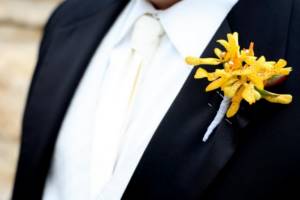
Previously, decorating the groom's suit was not a problem - a tie, a handkerchief in the breast pocket, a white artificial flower in the buttonhole. Today's newlyweds approach the issue with artistic imagination. Order jewelry from designers or create wedding boutonnieres with your own hands; master classes will give you ideas and reveal the secrets of needlewomen.
A small but important wedding attribute
The wedding begins a long family life, you and your children and grandchildren will admire photographs of the ceremony. Therefore, do not forget about aesthetics, let not only the image of the bride be bright and unforgettable. A boutonniere for the groom, created from fresh flowers that make up the bride’s bouquet, will help to emphasize unity with the bride and maintain harmony. Decorate the formal suits of your guests with small homemade bouquets. You can make your own boutonnieres for wedding guests in advance from inexpensive materials: ribbons, buttons, paper.
Don't forget about the bride's veil
Traditionally, a “bouquet in a buttonhole” is an attribute of a men’s suit. In a broader sense, boutonnieres are mini-compositions of fresh and artificial flowers that decorate the lapel of a jacket, a lady’s hairstyle or corset. A fashionable boutonniere for bridesmaids is made with your own hands in the form of an elegant flower bracelet.
Five tips for creating a boutonniere
- The groom's decoration is more luxurious than others. But remember: a boutonniere is not a bouquet, so it should not be too lush, the length should not be more than ten centimeters. Use large flowers, such as lilies, with caution.
- Choose fresh flowers without pollen, which will stain your outfit. The strong, intrusive aroma of a flower located close to the face is annoying and causes poor health.
- Don't buy artificial flowers. It’s better to style satin ribbons as a mini-flower bouquet, use compositions of buttons and beads.
- Boutonnieres support the style of the ceremony and are in harmony with other decorations and attributes. If you are making boutonnieres for a wedding with your own hands, notify guests about their color and texture. Guests will take this into account when choosing an outfit.
- Make one side as flat as possible. Don't overdo it with decor. Maintain your chosen style. Sloppy creativity looks vulgar.

Boutonniere made of fresh flowers
A boutonniere for the groom made from fresh flowers, as if taken from a wedding bouquet, looks impressive. Collect it with your own hands from one large or several smaller flowers, add a sprig of greenery. The beauty will have to be created at night or early in the morning shortly before the ceremony, otherwise the composition will wither, droop, and “not survive” until the evening festivities. It is recommended to put the selected flower in water for several hours, only then trim and remove the crushed petals. See how to make a boutonniere from fresh flowers.
Photo by Palace Resorts from Flickr.com
- Using pruning shears, cut the stem diagonally into three centimeters (scissors will crush it).
- Place the stem on the wire (floral wire) and wrap it with a cotton pad soaked in vodka or water. This way the flower will remain fresh longer. Apply elastic tape tightly on top. Avoid gaps and cuts.
- Add decor, carefully wrap with ribbon, avoiding creases. Decorate the joint with a bead or mini bow.
- Spray the flower, place the boutonniere in the refrigerator in a plastic bag - this will keep it fresh longer.
Assemble a composition of seemingly incompatible wild and garden flowers, dry and fresh leaves. Wrap decorative ribbon around it, reuniting such different elements.
At an autumn wedding, a boutonniere made of dry spikelets, acorns, and berries will look original.
The miniature bouquet for the groom is ready, but the boutonniere for the witnesses can be made with your own hands in advance from all kinds of materials that do not lose their freshness.
Satin ribbon boutonnieres
A satin ribbon can be used to brighten up a lively composition. Flowers made from ribbons and fabric will help out in the frosty winter. They are suitable for a European wedding, when a boutonniere bracelet is worn on the girls’ hands. Choose a color that matches your wedding dress. Make a boutonniere from satin ribbons with your own hands, inspired by our photos.
- Lay out wide flat petals in a circle, and in the center build a voluminous rose from a narrower ribbon.
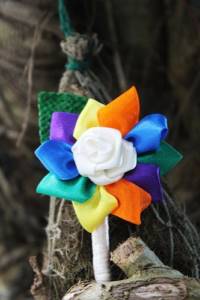
Photo www.accentsandpetals.com from Flickr.com
- Attach mother-of-pearl beads in the middle of the forget-me-not flowers. Decorate the boutonniere with the same beads on long legs, placing them around the flowers.
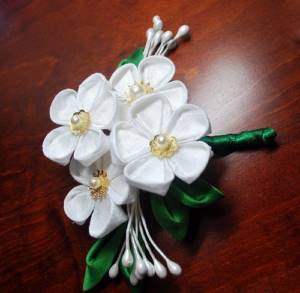
Photo by hanatsukuri (Mei) from Flickr.com
- Drape the ribbon and fold it into a strict, stylish bow or rosette.
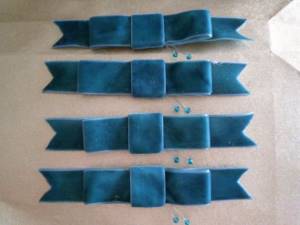
Photo by sufjan10 from flickr.com
Paper boutonnieres
Original, inexpensive paper boutonnieres will decorate your wedding without burdening your budget. Paper seems like a boring material, but flowers skillfully created from it look realistic and elegant. To create DIY boutonnieres for guests, use paper in bright and pastel colors; painted in one color and variegated. Combine with beads, buttons, feathers, narrow ribbons, and pieces of leather. Decorations using paper that imitates magazine sheets look unusual and fashionable.
Bright, voluminous corrugated paper boutonnieres are easy to make with your own hands, using the advice of craftswomen and a little practice. The textured material has wide possibilities, the flowers turn out interesting, original, and have a natural appearance.
Button boutonnieres
Move away from stereotypes, make a non-standard decoration for the groom and guests from buttons, and surprise the guests. Add creativity - create or order a button bridal bouquet for unity of style. This original alternative to the usual colors will be discussed by relatives and friends for a long time.
For creativity, choose single-color, colored accessories, large and small diameters, ball buttons and flower buttons, covered with fabric and thin leather. Complete the bouquets with pieces of tulle, pearls, curlicue ribbons, and thick flower leaves. Build “pyramids”, creating volume.
Let's give an example of how to make a boutonniere with your own hands.
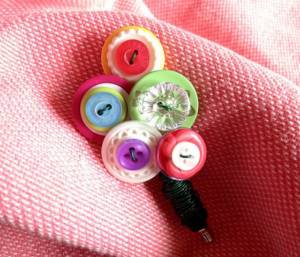
Photo by Beyond Sweet from Flickr.com
- Cut a thread for each flower. Make some extra length for convenience, then cut the ends straight. Bend the pieces of wire in half.
- String the buttons in the chosen order. Twist the wire at the bottom base.
- Gather the “flowers” into a bouquet by twisting the threads.
- Trim the excess ends and wrap the stem with tape.
- Wrap the top with decorative tape, securing the edge with glue.
Since ancient times, the boutonniere has been attached to the groom's suit from the heart side, symbolizing love for the bride. Modern trends allow miniature bouquets to decorate the wedding image of the bride, parents, witnesses, and guests.
Homemade boutonnieres will express your reverent attitude towards your loved ones.
pochti-zhena.ru
Assembling the boutonniere
The base on which the flowers will be attached should be quite rigid, but light. It is made from cardboard covered with fabric or thick felt of a suitable color. Flowers are attached using hot glue; if desired, leaves from green satin ribbon, beads, artificial ears, bows, and lace are added. For a wedding boutonniere, a thin fishing line with beads strung will be suitable.
Special latches for brooches are used as fastening, and pins are used as improvised means. It is convenient to make a small loop of elastic on the back - then the boutonniere can be threaded into a hairband, belt, or tie clip, making it a universal decoration for any occasion.
What it is
Content
The word itself comes from the French Boutonniere, which literally translates as “flower in the buttonhole.” The name is associated with the peculiarities of fastening the decoration - European dandies wore it exclusively on the left lapel of their jacket.
Modern wedding boutonnieres have become a wide field for florists to realize their imagination. The use of the accessory is no longer limited to the groom’s suit:
- It is attached to the bride's dress and to the outfits of witnesses.
- Festive tables or cards with the names of guests are decorated with similar decor.
- Miniature compositions worn on the hand often replace a bridal bouquet.
- If desired, these lovely, exquisite bouquets of flowers can also be used for all guests.
Boutonnieres have different meanings; in the wedding tradition, they symbolize loving hearts and their unity.
